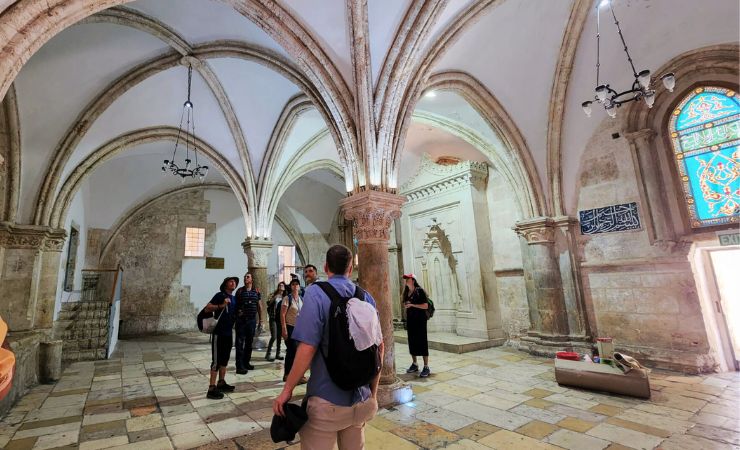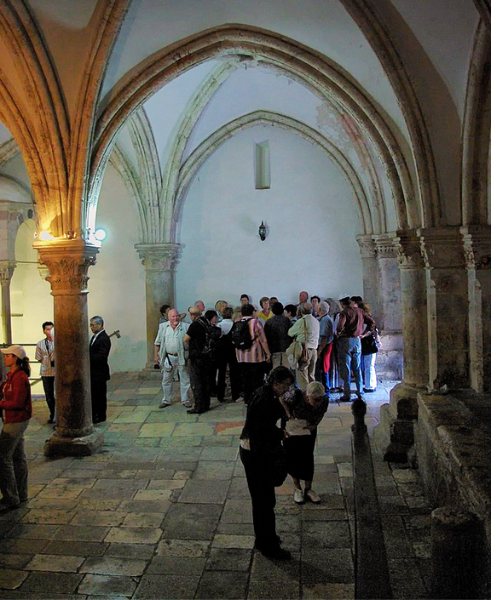The Room of The Last Supper: The Place of Two Traditions
Introduction
Nestled in Jerusalem, this sanctuary, also known as the Cenacle, is not just a historical site but a testament to faith that has stood the test of time.
Location
The Room of the Last Supper is situated on Mount Zion, just outside the Zion Gate in Jerusalem’s Old City.

The Biblical Context of the Last Supper
In the Room of the Last Supper, one of the most momentous events recorded in the New Testament ocured, according to Christian tradition, . It was the final meal that Jesus shared with his disciples before his crucifixion. According to the Bible, during the Last Supper, several significant events occurred:
The Breaking of Bread and Sharing of Wine
Jesus took bread, gave thanks, broke it, and gave it to his disciples, saying, “This is my body given for you; do this in remembrance of me.” He did the same with the wine, referring to it as his blood, establishing what is now known as the Eucharist or Holy Communion in Christian practice.
Jesus Predicts His Betrayal
Jesus revealed that one among the disciples would betray him. This was a reference to Judas Iscariot, who later betrayed Jesus for thirty pieces of silver.
Jesus Washes the Disciples’ Feet
In a humble act of service, Jesus washed his disciples’ feet and urged them to serve one another.
Jesus Foretells Peter’s Denial
Jesus predicted that Peter would deny him three times before the rooster crowed.
The Biblical Context of the Pentacost
Another important event believed to have occurred in The Room of the Last Supper is Pentacost. The Pentacost is celebrated fifty days after Easter Sunday and commemorates the descent of the Holy Spirit upon the Apostles and other followers of Jesus. This event marks the birth of the Christian Church. The importance of Pentecost lies in the empowerment and transformation it bestowed upon the disciples. It enabled them to spread the teachings of Jesus, laying the foundation for the growth of Christianity.
When the day of Pentecost arrived, they were all together in one place. And suddenly there came from heaven a sound like a mighty rushing wind, and it filled the entire house where they were sitting. And divided tongues as of fire appeared to them and rested on each one of them. And they were all filled with the Holy Spirit and began to speak in other tongues as the Spirit gave them utterance.
Acts 2:1-4
Historical Context: A Church Converted into a Mosque
The association of the site on southern Mount Zion with the Last Supper first appears in Christian sources from the fourth century C.E. Pilgrim accounts from this period are the earliest records of Christians visiting a structure on Mount Zion to commemorate the Last Supper. One example is a pilgrim from Bordeaux, who visited Jerusalem in 333 C.E. and mentioned seeing a synagogue on Mount Zion. It is unlikely this referred to a Christian church. Another account by Epiphanius also mentions a synagogue but distinguishes it from a nearby “church of God.”
Around 379–381 C.E., the large basilica known as Hagia Sion (“Holy Zion”) was built on the southwest hill of Jerusalem. It was intended to commemorate events from the life of Jesus and the apostles that were believed to have taken place there. The Liturgy of St. James refers to Hagia Sion as “the mother of all churches,” which could suggest an earlier Christian community or building on the site.
After Hagia Sion was built, the pilgrim Egeria visited Jerusalem and recorded that Mount Zion was regarded as the site of the Pentecost event. She mentioned that “another church” existed there, implying Hagia Sion may have been built near or over an earlier structure. Later accounts, including one from Bishop Eucherius of Lyons in the mid-fifth century, described a church on Mount Zion believed to have been built by the apostles. This church was considered separate from Hagia Sion. Some accounts describe the structure as a house commemorating the Last Supper, resurrection appearances, and possibly the assumption of Mary.
Artistic evidence from the sixth century also supports the existence of a smaller sacred structure next to Hagia Sion. Mosaics from the Church of Santa Maria Maggiore in Rome and the Church of St. George in Madaba, Jordan, show the large basilica flanked by a small building with a slanted roof, depicted as significant.
While literary and artistic sources point to a long-standing tradition linking the site with the Last Supper starting in the fourth century, direct archaeological evidence connecting the current structure to the first century C.E. is inconclusive. Some scholars argue that parts of the building may predate the Byzantine period, suggesting an earlier structure, possibly associated with the first Christian community in Jerusalem. Others maintain that the structure did not exist before the fourth century. Limited archaeological investigation, due to religious and political sensitivities, has left many questions unanswered.
Despite the lack of clear archaeological proof, the identification of the Cenacle as the location of the Last Supper has been maintained through pilgrim testimonies, historical writings, and artistic representations from the fourth century onwards. This tradition has continued across periods of destruction, reconstruction, and changes in religious control.
The current Gothic structure dates to between the 12th and 14th centuries. Architectural features include elements of Christian Gothic style, along with later Muslim modifications such as a mihrab and Arabic inscriptions, reflecting its use as a mosque during part of its history. Medieval graffiti uncovered on the site confirms its long-standing significance as a place of Christian pilgrimage.



Archaeological Findings at the Room of the Last Supper
The Room of the Last Supper, or the Cenacle, has undergone significant transformations over the centuries.
It is architecturally divided into six rib-vaulted bays, supported by three freestanding columns and six pillars along the side walls. One of the columns is completely independent of the wall, suggesting that the wall may not be original to the building.
The column and pillar capitals provide some clues to the building’s origin, but no definitive answers. One of the capitals, with its spiky leaves and scrolls, is similar to the work produced by a 12th-century sculpture workshop at the Temple site in Jerusalem. This workshop included artists from various Western regions, who brought their native stylistic traits with them. The workshop produced sculptures for many Crusader projects and structures, including the al-Aqsa mosque. This evidence supports the theory that the Cenacle dates back to the 12th century. But there are other theories that claim the Cenacle was built at a later time.
The Room of the Last Supper’s ceiling has the “Agnus Dei” or “Lamb of God” symbol, and it is filled with decorated medievil pillars. The room is rectangular and Gothic in style. One of the intriguing aspects of the room is the stained glass Ottoman windows and Arabic inscriptions. Near the minaret, stairs lead up to the roof, which offers breathtaking views of the Mount of Olives.
- Impressive Gothic Structure: The Room of the Last Supper is constructed in a Gothic style, characterized by a rectangular shape, vaulted ceilings, and arches. The Gothic elements of the structure are representative of the architectural styles that prevailed in medieval Europe.
- Agnus Dei Symbol: The”Agnus Dei” or “Lamb of God” symbol at the apex of one of the room’s arches holds deep significance in Christian tradition.
- Decorated Medieval Pillars: The room contains pillars that are typical of medieval architecture. These pillars are ornately decorated and support the vaulted ceiling. One of the pillars is shaped as a Plican, an early symbol of Christianity.
- Decorated Windows: The chamber room within the Cenacle resembles a mosque, complete with stained glass Ottoman windows. These windows have intricate designs and include Arabic inscriptions, reflecting the Muslim influence on the site. The mosque features a minbar, traditionally used in mosques for sermons.
Medieval Inscriptions and Graffiti: These were etched onto the room’s walls between the 14th and 16th centuries. These are almost invisible to the naked eye and provide unique insight into the geographical origins and diversity of the medieval pilgrims who visited the site.
Additional Information
- Fourth Century: The tradition of the Cenacle location does not originate before this century. The site becomes a major feature of Christian pilgrimage.
- Late 4th Century: Epiphanius, bishop of Salamis, writes about the site being spared during the destruction of Jerusalem in 70 AD.
- Byzantine Period: A large basilica, Hagia Sion, is depicted on southern Mount Zion in mosaics, often flanked by a smaller building believed to be the Cenacle. This period saw significant Christian worship at the site, recognized as “Holy and glorious Sion, mother of all churches.”
- Until 1337: Syrian Christians maintain custody of the Cenacle.
- Late Middle Ages (late 13th century onwards): Graffiti in Western European churches, including the Cenacle, becomes widespread and is a subject of research. The Cenacle is the heart of a Franciscan monastery during this time.
- 1299: Mongol conquest of Syria and the Levant. Armenian troops, allied with the Mongols under King Hethum II, reach Jerusalem.
- 1300: An Armenian inscription reading “Christmas 1300” is found as graffiti in the Cenacle, likely left by Armenian troops who reached Jerusalem with the Mongols in 1299.
- 1337: The Cenacle passes into the custody of the Franciscan Order of Friars.
- 1436: Tristram von Teuffenbach of Styria travels to Jerusalem with Frederick Habsburg, the future Holy Roman Emperor. Tristram’s family crest is found as graffiti in the Cenacle.
- Early 16th Century (1516): Ottoman rule begins in Jerusalem.
- 1524 (930 AH): During the rule of Suleiman the Magnificent, Ottoman authorities take possession of the Cenacle and convert it into a mosque, the Masjid an-Nabī Dāwūd (Mosque of the Prophet David). An Ottoman datestone commemorates this conversion.
- 1551: The Franciscans are fully evicted from their surrounding buildings. Non-Muslims are banned from entering the Cenacle except by bribing custodians.
- Late 19th Century (around 1898): The German Kaiser acquires land near the Cenacle for the construction of the Church of the Dormition, honoring the assumption of Mary. This prompts scholarly and archaeological review of the area, including the Cenacle. H. Renard works as architect and archaeologist on the Dormition Church site.
- 1948: Jacob Pinkerfeld conducts a survey of the Cenacle site.
- 1948-1967: The Old City of Jerusalem is under Jordanian control. The Zion Gate is the border between Israel and Jordan during this time. The “trench” or tunnel on Mount Zion is used by Israelis to access Mount Zion from the Israeli side.
- 1948 onwards: The State of Israel takes possession of the holy places on Mount Zion, including the Cenacle hall.
- May 2014: Pope Francis visits the Holy Land and is permitted to celebrate Mass in the Cenacle.
- Present Day: The Cenacle building houses a synagogue on the first floor (traditionally the Tomb of King David), the “Upper Chamber” (Cenacle) on the second floor, which hosts pilgrims but no regular Christian services, and a mosque on the third story. All three Abrahamic religions coexist at the site.
Nearby Sites
- King David’s Tomb: Located in the lower story of the same building that houses the Room of the Last Supper, It’s believed to be the burial place of the biblical King David.
- The Jewish Quarter: Just passed the Zion Gate, the Jewish Quarter is revealed. This area is home to several ancient synagogues, and historical buildings, and the Broad Wall erected by King Hezekiah in the 8th century BC.
- St. James Cathedral This cathedral is dedicated to two Saints named James – St. James the Greater, one of Jesus’ twelve apostles, and St. James the Just, who was the brother of Jesus.
- The Roman Cardo Maximus: The Cardo is a remarkable representation of Roman engineering. Once the main thoroughfare in ancient Jerusalem, this grand column-lined street now houses a variety of shops and galleries.



